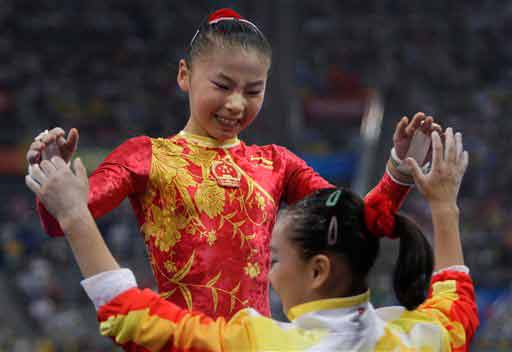Why Red Is Such a Potent Color

The Olympic athletes have been parading around like fashionistas in an array of colorful outfits, and we, their adoring public, can't resist commenting on the style and color of their high-end athletic wear. My favorite was the faux silk, faux embroidered, slinky red leotards of the Chinese women's gymnasts.
Apparently, as researchers have recently discovered, the choice of red for those leotards might also have given the Chinese gymnasts an advantage. But why is the color red so impressive?
The answer lies in our tree-living past.
In the back of the vertebrate eyeball are two kinds of cells called rods and cones that respond to light. Cones take in a wide range of light, which means they recognize colors, and they are stimulated best during daylight. Rods respond to a narrower range of light (meaning only white light) but notice that light from far away and at night.
Isaac Newton was the first person to hold up a prism and refract white light into a rainbow of colors and realize that their might be variation in what the eye can see. Color comes at us in electromagnetic waves. When the wavelength of light is short we perceive purple or blue. Medium wavelengths of lights tickle the cones in an other way and we think green. Short light wavelengths make those cones stand up and dance as bright spots of yellow, orange and red.
Various animals distinguish only parts of that rainbow because their cones respond in different ways. Butterflies, for example, see into the ultraviolet end of the rainbow which allows them to see their own complex markings better than we can. Foxes and owls are basically color blind and it doesn't matter because they are awake at night when the light spectrum is limited anyway.
Humans are lucky enough to be primates, animals with decent color vision, and we can thank monkeys for this special ability.
Get the world’s most fascinating discoveries delivered straight to your inbox.
Long ago, primitive primates that resemble today's lemurs and lorises saw only green and blue, the longer wavelengths of color. But when moneys evolved, around 34 million years ago, their cones became sensitive to even shorter wavelengths of color and they saw red.
And what a difference. With red, the forest comes alive. Instead of a blanket of bluish-green leaves, the world is suddenly accented with ripe red, yellow, and orange fruits, and even the leaves look different.
For a monkey leaping through the forest canopy, color vision would be an essential advantage. Unripe fruit doesn't have enough carbs to sustain a hungry primate and they taste really sour. Unripe leaves not only taste bad, they are toxic and indigestible.
For the first humans foraging about the forest and savannah around 5 million years ago, it would have been be much more efficient to spot a ripe fruit or tuber than bite into a zillion just to get the right one. And so humans ended up with color vision even though we no longer live in trees.
But color is more than wavelengths, more than an indicator of ripeness, to us.
Color has become symbolic, meaning it has meaning, and that meaning is highly cultural.
Chinese athletes and Chinese brides wear red because red is considered lucky. The U.S. athletes also wear red because that bright color is in the U.S. flag, and because designers of athletic wear, as well as scientists, know that red gets you noticed.
- Humans: The Strangest Species
- The Olympics: History, Controversy and Just Plain Strange
- Amazing Animal Abilities
Meredith F. Small is an anthropologist at Cornell University. She is also the author of "Our Babies, Ourselves; How Biology and Culture Shape the Way We Parent" (link) and "The Culture of Our Discontent; Beyond the Medical Model of Mental Illness" (link).


